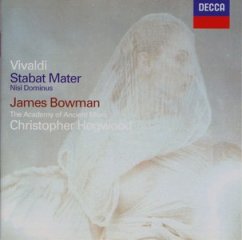Antonio Vivaldi - Stabat Mater, Nisi Dominus, Concerto (Hogwood) [2003]
Antonio Vivaldi - Stabat Mater, Nisi Dominus, Concerto (Hogwood) [2003]

1. Stabat Mater in F minor, RV 621: Stabat Mater dolorosa / Cuius animam gementem / O quam tristis et afflicta
2. Stabat Mater in F minor, RV 621: Quis est homo / Quis non posset contristari / Pro peccatis suae gentis
3. Stabat Mater in F minor, RV 621: Eia Mater, fons amoris / Fac ut ardeat cor meum / Amen
4. Concerto in G minor, RV 153
5. Nisi Dominus in G minor, RV 608: Nisi Dominus
6. Nisi Dominus in G minor, RV 608: Vanum est vobis / Surgite postquam sederitis
7. Nisi Dominus in G minor, RV 608: Cum dederit dilectis suis somnum
8. Nisi Dominus in G minor, RV 608: Sicut sagittae in manu potentis
9. Nisi Dominus in G minor, RV 608: Veatus vir qui implevit
10. Nisi Dominus in G minor, RV 608: Gloria Patri et Filio / Sicut erat in principio / Amen
James Bosman - countertenor
The Academy of Ancient Music
Christopher Hogwood – conductor
Antonio Vivaldi had no outlet for composing sacred vocal music at the Ospedale della Pieta, where such music was the responsibility of the choirmaster, until 1713 when the reigning choirmaster quit and was not replaced until 1719. A man of Vivaldi's faith, however, could be expected to seek out opportunities to write such music. He evidently found one in 1711 at the Feast of the Purification of the Blessed Virgin at the Chiesa della Pace in Brescia, where he and his father had been invited to play the violin. Following persuasions unknown, the church's music expenditures book details payment for a Stabat Mater composed by Vivaldi in 1712. The Chiesa della Pace rarely commissioned new music and the Stabat Mater was not even a standard text at the time (it was added to the Roman Missal and Breviary in 1727), but Vivaldi's skill as a composer evidently won the day, as one would expect when considering this masterpiece. Vivaldi set 10 of the 20 verses of the Stabat Mater, marking it as a hymn for Vespers, but while every other hymn Vivaldi composed used strict strophic form, here Vivaldi repeated the music from movements 1-3 in movements 4-6, and ended with three movements with new music. However, many of the movements contain thematic resemblances. All nine movements are also cast in F minor except the second and fifth, which are in C minor, and until the "Amen," the fastest tempo in the piece is an Andante. All of these techniques work to sustain an unrelievedly bleak atmosphere suitable to a depiction of Mary's anguish while watching Jesus suffer on the cross. Vivaldi brings out the dark coloring of the male alto voice with spare, sustained accompaniments, falling melodies, and in the C minor movements, extended, almost desperate closing melismas. "Eja Mater," the seventh movement, illustrates Mary's suffering with a whip-like string figure that sounds especially dramatic coming after the repeated music. The cumulative effect is shattering and the sorrowful atmosphere dominates right up to the final chords of the "Amen": a picardy third perhaps suggesting the light that followed the crucifixion. The light here, however, only makes the darkness that has come before seem all the more oppressive. ---Andrew Lindemann Malone, Rovi
Vivaldi's Nisi Dominus, RV 608, is in G minor and is scored for solo voice, viola d'amore, a small string group, and continuo. It is one of two settings by Vivaldi of the Nisi dominus (Psalm 126 or 127) text. The other, RV 803, only recently authenticated, dates from the late 1730s, but RV 608 is an early work, perhaps composed for the Venetian girls' orphanage that employed the composer in the 1710s. In nine short sections, the work is remarkable for its variety; it supports the conclusion that the obscurity of Vivaldi's vocal music is due more to historical accident than to any lack of quality. Though it has been sung by male countertenors, the vocal part would probably have been composed for a female alto if the work indeed originated during Vivaldi's tenure at the orphanage.
It is the variety of instrumental accompaniments, as vivid as those of any Baroque opera, that brings the work to life. The third section, "Surgite" ("It is vain for you to rise up early, to sit up late, to eat the bread of sorrows") is an accompanied recitative with vigorous illustrations of both the early riser and the bread of sorrows in the orchestral strings. The following "Cum dederit" ("When He shall give sleep...") is a masterful chromatic siciliana that ranks among the most alluring Baroque depictions of sleep, complete with string mutes. "Sicut sagittae" ("Like arrows in the hand of a mighty man...") offers still more operatic text-painting, with stabbing unisons dominating the texture. The "Gloria" section replaces the usual festive mood with a meditative, dark setting, and the other movements are similarly original. Some have simple continuo accompaniment, while others have a viola d'amore part (perhaps written for Vivaldi's own use, for he was a virtuoso player on the instrument) taking on a concerto-like role. It is perhaps only the presence of that unusual instrument that has kept this lovely work from the pinnacles of popularity where some of Vivaldi's other compositions reside. ---James Manheim, Rovi
download: uploaded yandex 4shared mediafire solidfiles mega zalivalka filecloudio anonfiles oboom
Zmieniony (Niedziela, 22 Czerwiec 2014 11:40)








